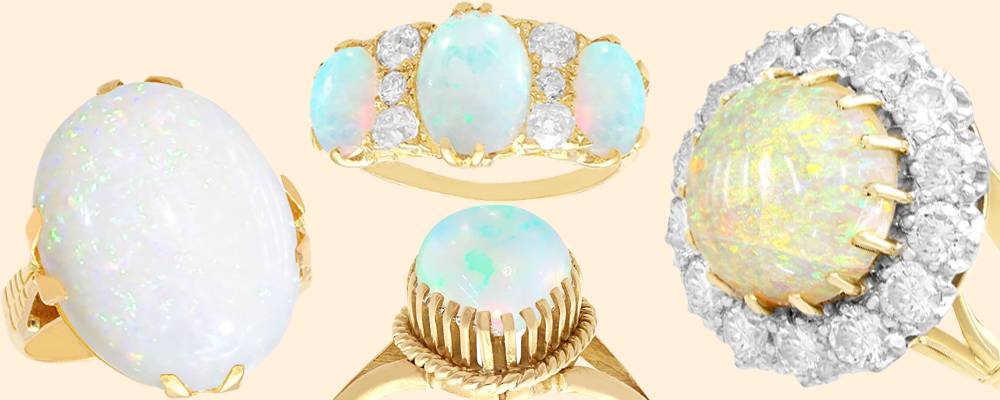White Opal Ring
Antique and Vintage White Opal Rings for Sale
Explore our fine collection of antique and vintage white opal rings for sale. Our collection includes fine rings adorned with diamonds and crafted in gold and platinum.
All opal jewellery purchased will arrive gift wrapped with a complementary insurance valuation and will include free global shipping.
Andrew Campbell, using his 40 years’ experience within the antique jewellery industry, handpicks all vintage and antique white opals for sale.

White opals are believed to enhance creativity and inspire artistic expression. The opals famous play of colours has been a creative influence for centuries. In 75A AD, the Roman scholar, Pliny, compared the assortment of colour within the gemstone equal to ‘the deepest and richest colours of painters’, and have since been a point of influence for many artists.
Throughout centuries, the white opal has been associated with a variety of affiliations. In the modern day, the white opal is seen as a symbol of hope and purity and recognised as October’s birthstone. Explore our range of white opal jewellery online now.
White Opal Ring Frequently Asked Questions
White opal is a type of opal, a popular and sought after gemstone. A white opal refers to it’s pale white or light body though, as with any type of opal, a white opal can display a variety of colours in the gemstones play of colours.
Precious opals display fire or play of colours, the gemstones feature characteristic. The multi-coloured flashes within the gemstone are the result of diffraction within the stone, and can been seen within white opals in contrast to their milky white appearance.
The history of opals traces back thousands of years, with evidence of their admiration found in ancient civilizations such as the Greeks, Egyptians and ancient Romans, who gave this gemstone the name ‘opalus’, meaning ‘precious stone’.
Gemmologists suggest the evidence of human use of opals dates back to 4000 BC, after archaeologists discovered early relics of white opals in a Kenyan cave in 1939. With modern technology and further discoveries, archaeologists are able to determine the rich history and symbolism of the opal.
White opals, specifically, were beloved by the ancient Greeks, who believed the gem would open the third eye, bestowing powers of visions and prophecy onto the wearer. This association with vision is continued throughout centuries and various cultures.
In the middle ages the opal was known as the ‘eye stone’, based off the belief the gemstone would strengthen eyesight. Europeans of the Middle Ages also believed the white opal to be particularly significant to those with blonde hair, as a tool of protection against hair loss.
In the late 18th and early 19th centuries, the opal began to be associated with bad luck, following famine and the fall of various monarchs. Queen Victoria dismissed these notions, wearing opals throughout her reign and adhering to a large personal collection of the gemstone.
Whilst opals are found around the world, the opal is Australia’s national gemstone, on account of producing around 95% of the world’s precious opals. Australian opals were first commercially mined in 1875 and today Coober Pedy (South Australia) is the main producer of white opals.


















